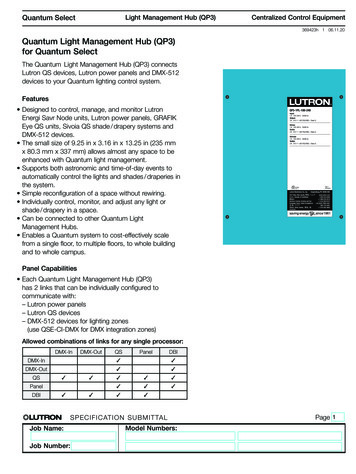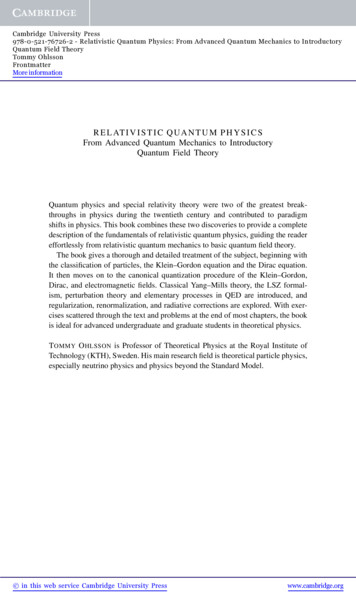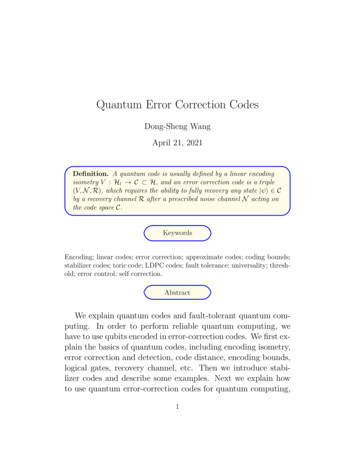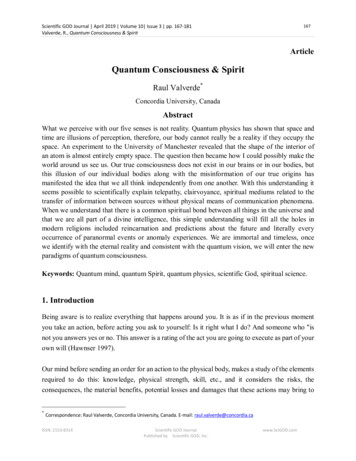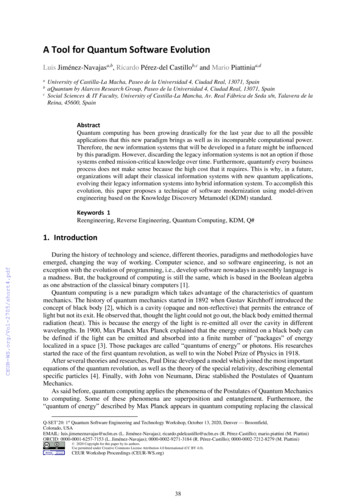
Transcription
A Tool for Quantum Software EvolutionLuis Jiménez-Navajasa,b, Ricardo Pérez-del Castillob,c and Mario Piattiniaa,dabcUniversity of Castilla-La Macha, Paseo de la Universidad 4, Ciudad Real, 13071, SpainaQuantum by Alarcos Research Group, Paseo de la Universidad 4, Ciudad Real, 13071, SpainSocial Sciences & IT Faculty, University of Castilla-La Mancha, Av. Real Fábrica de Seda s/n, Talavera de laReina, 45600, SpainAbstractQuantum computing has been growing drastically for the last year due to all the possibleapplications that this new paradigm brings as well as its incomparable computational power.Therefore, the new information systems that will be developed in a future might be influencedby this paradigm. However, discarding the legacy information systems is not an option if thosesystems embed mission-critical knowledge over time. Furthermore, quantumfy every businessprocess does not make sense because the high cost that it requires. This is why, in a future,organizations will adapt their classical information systems with new quantum applications,evolving their legacy information systems into hybrid information system. To accomplish thisevolution, this paper proposes a technique of software modernization using model-drivenengineering based on the Knowledge Discovery Metamodel (KDM) standard.Keywords 1Reengineering, Reverse Engineering, Quantum Computing, KDM, Q#1. IntroductionDuring the history of technology and science, different theories, paradigms and methodologies haveemerged, changing the way of working. Computer science, and so software engineering, is not anexception with the evolution of programming, i.e., develop software nowadays in assembly language isa madness. But, the background of computing is still the same, which is based in the Boolean algebraas one abstraction of the classical binary computers [1].Quantum computing is a new paradigm which takes advantage of the characteristics of quantummechanics. The history of quantum mechanics started in 1892 when Gustav Kirchhoff introduced theconcept of black body [2], which is a cavity (opaque and non-reflective) that permits the entrance oflight but not its exit. He observed that, thought the light could not go out, the black body emitted thermalradiation (heat). This is because the energy of the light is re-emitted all over the cavity in differentwavelengths. In 1900, Max Planck Max Planck explained that the energy emitted on a black body canbe defined if the light can be emitted and absorbed into a finite number of “packages” of energylocalized in a space [3]. Those packages are called “quantums of energy” or photons. His researchesstarted the race of the first quantum revolution, as well to win the Nobel Prize of Physics in 1918.After several theories and researches, Paul Dirac developed a model which joined the most importantequations of the quantum revolution, as well as the theory of the special relativity, describing elementalspecific particles [4]. Finally, with John von Neumann, Dirac stablished the Postulates of QuantumMechanics.As said before, quantum computing applies the phenomena of the Postulates of Quantum Mechanicsto computing. Some of these phenomena are superposition and entanglement. Furthermore, the“quantum of energy” described by Max Planck appears in quantum computing replacing the classicalQ-SET’20: 1st Quantum Software Engineering and Technology Workshop, October 13, 2020, Denver — Broomfield,Colorado, USAEMAIL: luis.jimeneznavajas@uclm.es (L. Jiménez-Navajas); ricardo.pdelcastillo@uclm.es (R. Pérez-Castillo); mario.piattini (M. Piattini)ORCID: 0000-0001-6257-7153 (L. Jiménez-Navajas); 0000-0002-9271-3184 (R. Pérez-Castillo); 0000-0002-7212-8279 (M. Piattini) ️ 2020 Copyright for this paper by its authors.Use permitted under Creative Commons License Attribution 4.0 International (CC BY 4.0).CEUR Workshop Proceedings (CEUR-WS.org)38
bit (the smaller unit of information) with qubits, acquiring an exponential growth in computationalpower.Although this new technology is not mature enough, the organizations must be prepared to face amodernization towards it. Having in the business processes a computational power for simulation andcalculation faster than the actual supercomputer will gave to the organizations a high value and willbring new market opportunities. This modernization does not mean to fully discard the classicalinformation systems, because some of the supported business processes will not be probably supportedthrough quantum computing, and even if those business processes are quantumfied, the gain will below against the high cost. The same happens with the information systems that embedded a vast amountof mission-critical knowledge during their evolutionThe solution of the evolution of the actual systems towards quantum computing could be in thedevelop of classical-quantum systems, where in this paper have been denominated hybrid informationsystems. These systems consist of a master classical system that make requests to quantum computers(typically in the cloud) to compute specific quantum algorithms. However, the evolution from classicalsystems into hybrid has not been treated before and there are no methods for dealing with this problem.Our proposed solution is based on reengineering, specifically on Architecture-Driven Modernization[5]. This modernization is an evolution of traditional reengineering which follows Model-DrivenEngineering (MDE) approach advocating the usage of KDM [6]. KDM ensures the representation, intechnology-agnostic way, the architecture of the system including its interrelationships. The abstractionachieved through KDM ensures the interoperability between reverse engineering tools and othersoftware modernization tools.The remaining of the paper is structured as follows: Section 2 explains the state of art of quantumcomputing and reengineering. Then, Section 3 introduces Quantum Software Reengineering where theproposed technique is framed.2. State of the Art2.1. Quantum ComputingQuantum computing started in the eighties when Paul Benioff proposed a quantum mechanicalmodel of the Turing machine [7]. Some years later, the physicists Richard Feynman [8] and Yuri Manin[9] discovered the potential of how a quantum computer can simulate and process than a classicalcomputer cannot. After a few years, the mathematician Peter Shor, developed an algorithm for quantumcomputers which factors integers, this means that by means of quantum computing, RSA-encryptedcommunications could be decrypted [10]. It should be noticed that RSA-encryption is used for digitalsignatures and not forgetting that HTTPS protocol uses this kind of encryption between clients andservers.Quantum mechanics changes the traditional bit, the smaller unit of information, with qubit (quantumbit). A qubit is usually represented with the electron spin or photons among other subatomic particles.A qubit is a multiple status quantum system (not only defined by zero and one as a classical bit) wherethere exist infinite possible values, as a sphere (see Figure 1). This means that a qubit state might bezero and one at the same time. This phenomenon is known as superposition [11]. Superposition is thesecrete of the exponential computational power of quantum computers since n qubits are representedby a superposition state vector in 2n.39
Figure 1. Representation of a qubit based on the model of Felix Bloch [12]The qubit’s mathematical definition of its state is represented by a vector following a special notationnamed ket-bra notation. This quantum state is represented with the letter 𝜓, where 0⟩ and 1⟩ act fordepiction of the two different energy levels (which are 0 and 1). The letters α and β indicate theprobabilitiesorproportionofthequbittobe 0⟩and 1⟩,i.e., 𝜓⟩ ( 𝛼 0⟩ 𝛽 1⟩ ). Thus, the probabilities are α 2 for 0⟩ and β 2 for 1⟩.Another important quantum phenomenon is the quantum entanglement. This property of quantummechanics was predicted, not discovered, by Albert Einstein, Boris Podolsky and Nathan Rosen, andfirst named as EPR Paradox. The paradox suggested that the Laws of Quantum Mechanics wereincomplete because until that moment no one could explain how, if two particles that interacted in thepast (so, are interlaced), why if you manipulated the state one of those particles, the other’s one statealso changes instantly, with no apparent connection between them [13]. This new property violated thetheory of relativity. After a few years, John S. Bell demonstrated mathematically the EPR Paradoxconcluding that the quantum mechanic’s phenomena cannot be explained in terms of classical physics[14].Likewise happened in sixties with the space race, nowadays there is a similar race to get new kindof supremacy, called quantum supremacy. This race’s goal is to demonstrate that quantum computingcan solve a problem that a classical computer cannot[15]. Among many other, the head-to-headcompetitors of this race are IBM and Google. In fact, Google recently announced that has alreadyachieved the quantum supremacy with a 54-qubit computer [16]. However, participate in this race isdifficult due to the actual price of quantum computers, which can ascend up to dozens of millions ofeuros besides all the maintenance that requires and only a few companies can afford it.Together with the quantum computers, various quantum programming languages have beendeveloped such as Q# or QASM among others. These programming languages include abstractions forbuilding quantum gates and other quantum operations [13]. Most of these programming languages areopen-source and can be used by anyone interested. On the one hand, having these open-sourcelanguages encourages the people to contribute on the global knowledge, developing algorithms and newtheories. On the other hand, there are not guides of good practices to develop quantum code. There arenot guidelines of how quality quantum software must be developed. To alleviate this problem theTalavera Manifesto for Quantum Software Engineering and Programming [14] proposes good practicesfor the correct development of quantum software.40
2.2.Traditional ReengineeringSoftware technology evolves over time, so information systems can (or should) evolve consequently.This evolution can have negative effects on those systems that were developed in the past, likedegradation or aging, making those information systems legacy, which means that the source code thatwas developed could be technologically obsolete [17]. Reengineering allows the preservation of thebusiness knowledge, making possible to carry out evolutionary maintenance of the legacy informationsystems assuming low risks and low costs [18]. The overall reengineering process is typically presentedas a “horseshoe” model [19], see Figure 2, where reengineering consists of three main stages:1.Reverse engineering: the system is analysed to identify its components andinterrelationships and create abstract representations of the system in another form or at ahigher level of abstraction.2.Restructuring: the transformation from one representation form to another at the samerelative abstraction level. This stage can consist of refactoring, i.e., the internal structure isimproved while preserving the subject system’s external behaviour (functionality andsemantics). Or additionally, it can add new functionality at this abstraction level.3.Forward engineering: the final stage consists of the renovation by generating the newsource code and other software artefacts at lower abstraction level.New business requirementsSource CIMmodelRefactoring & optimizationSource PIMmodelReverse EngineeringRecoveryTarget PIMmodelTarget PSMmodelGenerateLegacy SystemForward EngineeringSource PSMmodelRestructuringTarget CIMmodelImproved SystemFigure 2. Horseshoe Modernization Model (taken from [20]).The traditional reengineering projects fail when dealing with specific challenges like thestandardization and automation of the reengineering process [21]. First, standardization constitutes aproblem since the reengineering process is typically carried out in an ad hoc manner. Thus,reengineering projects must focus their efforts on a better definition of the process. Furthermore, thecode cannot be the only software asset that the standardization covers, since “the code does not containall the information that is needed” [22]. The reengineering process must be formalized to ensure anintegrated management of all of the knowledge involved in the process such as source code, data,business rules, and so on. Second, automation is also a very important problem. In order to preventfailure in large complex legacy systems, the reengineering process must be more mature and repeatable[23]. In addition, the reengineering process needs to be aided by automated tools so that companies canhandle the maintenance cost [21].In order to address the mentioned problems, traditional reengineering evolved toward Architecturedriven Modernization (ADM) [24]. ADM consists of the use of tools that facilitate the analysis,refactoring and transformation of existing system towards a modernization for supporting new41
requirements, migration of systems or even their interoperability. To accomplish this, ADM makes useof reengineering and Model-Driven Engineering (MDE) [25], where software development’s approachis done through defined abstract models and automatic transformation between them.As a part of ADM initiative, the OMG released the Knowledge Discovery Metamodel (KDM) withina broad set of proposed standards [26]. KDM addresses the main challenges that appear in themodernization of legacy information systems and it is the cornerstone of the set of proposed standards,since the other standards are defined around KDM [6]. KDM uses the OMG’s standards for representingthe models through XMI.KDM defines a metamodel which represents the software artifacts which are involved in the legacyinformation system, providing an accurate view of the functions and structures of it. Reverseengineering techniques use KDM to build high-abstraction level models in a bottom-up manner startingfrom software legacy artifacts.The KDM specifies a metamodel to represent legacy knowledge metamodels because KDM isdefined as an Entity-Relationship model according to the MOF (Meta Object Facility) meta-model [27]like UML, CWM and SPEM. KDM can be seen as a metamodel to represent platform-independentmodels. KDM can also work as common interchange format shared for reverse engineering tools,software analysis tools, and any other modernization tool.3. Quantum Software ReengineeringAs said in the introduction, quantum software reengineering might be the solution for dealing withthe challenges that the evolution toward hybrid systems bring. Based on software modernization (itsevolution adding an MDE approach), quantum software engineering could be used in threecomplementary scenarios:1. Migrate existing, isolated quantum algorithms and integrate them into the hybrid informationsystems.2. Migrate classical legacy information systems toward hybrid architectures that support theintegration of classical-quantum information systems.3. Transform or add new business operations supported by quantum software that will beintegrated into the target hybrid systems.In Figure 3 is shown the overall quantum reengineering process, where it can be seen that the solutionproposed to the evolution towards hybrid systems uses standards as KDM and UML as main cores. Thefirst stage of quantum reengineering is reverse engineering which analyses existing information systemsartefacts such as the source code, database schemas, etc. Not only classical information systems(scenario 1) could be inspected but quantum programs (scenario 2) too. The output of this phase is a setof KDM files which represents all the different perspectives and concerns of the legacy informationsystems, preserving all the business knowledge acquired along the time and reducing the impact on theimplantation of quantum programs.The second stage is restructuring (see Figure 3), where the KDM models are transformed into highabstraction level models which represents both the analysis and design aspects of the target hybridsystem with UML. Once the representations are done, the software engineers could model the targethybrid system.The last phase consists of forward engineering (see Figure 3), which is composed with a set oftechniques that takes the representation done in the previous phase and generate the source code fortarget hybrid system. Nowadays, exists a vast number of source code generators from UML models.However, there are not generators of quantum source from high level abstraction models.42
Res tr uctur ingAutomaticmodel refactoringExpert-basedmodel refactoringKDM ModelsUML ModelsExtendedQuantum codeparserExistingQuantumProgramsExtendedCode, docs, database, etechniquesEngineer ingEngineer ingModeltransformationForwardRev er s eNewQuantumProgramsTarget ClassicalQuantum SystemFigure 3. Quantum reengineering process.4. AcknowledgementsThis research has been partially funded by the G3SOFT (SBPLY/17/ 180501/ 000150), and GEMA(SBPLY/17/180501/000293) projects funded by the ‘Direc-ción General de Universidades,Investigación e Innovación – Consejería de Edu-cación, Cultura y Deportes; Gobierno de Castilla-LaMancha’. This work is also part of the projects BIZDEVOPS-Global (RTI2018-098309-B-C31) andECLIPSE (RTI2018-094283-B-C31) funded by Ministerio de Economía, Industria y Com-petitividad(MINECO) & Fondo Europeo de Desarrollo Regional (FEDER); and SMOQUIN (PID2019104791RB-I00) funded by Spanish Ministry of Science and Innovation (MICINN).5. References[1] Washburn, S.J.E.E., Boolean algebra in electronic circuit design. 1954. 73(2): p. 164-164.[2] Kirchhoff, G., Licht; ff. Ann. Phys. Chemie, 1860. 109: p. 275.[3] Planck, M., Ueber das Gesetz der Energieverteilung im Normalspectrum. Annalen der Physik,1901. 309: p. 553-563.[4] Dirac, P.A.M., The Quantum Theory of the Electron. Proceedings of the Royal Society of LondonSeries A, 1928. 117: p. 610-624.[5] Pérez-Castillo, R., I.G.R. de Guzmán, and M. Piattini, Architecture-driven modernization, inModern Software Engineering Concepts and Practices: Advanced Approaches. 2011, IGI Global.p. 75-103.[6] Pérez-Castillo, R., I.G.R. De Guzmán, and M. Piattini, Knowledge Discovery Metamodel-ISO/IEC19506: A standard to modernize legacy systems. Computer Standards and Interfaces, 2011. 33: p.519-532.[7] Benioff, P., The computer as a physical system: A microscopic quantum mechanical Hamiltonianmodel of computers as represented by Turing machines. Journal of Statistical Physics, 1980. 22:p. 563-591.43
[8] Feynman, R.P., Simulating physics with computers. International Journal of Theoretical Physics,1982. 21: p. 467-488.[9] Manin, I.I., Vychislimoe i nevychislimoe. 1980.[10] Shor, P.W., Polynomial-time algorithms for prime factorization and discrete logarithms on aquantum computer. SIAM Journal on Computing, 1997. 26: p. 1484-1509.[11] Schrödinger, E., Die gegenwärtige Situation in der Quantenmechanik. Die Naturwissenschaften,1935. 23: p. 807-812.[12] Bloch, F., Nuclear induction. Physical Review, 1946. 70: p. 460-474.[13] Einstein, A., B. Podolsky, and N. Rosen, Can Quantum-Mechanical Description of PhysicalReality Be Considered Complete? 1935. 47: p. 777.[14] Bell, J.S., On the einstein podolsky rosen paradox. Physics Physique Fizika, 1964. 1(3): p. 195.[15] Preskill, J., Quantum computing and the entanglement frontier. 2012: p. 1-18.[16] Google's Quantum Blog. 2019.[17] Ulrich, W.M., Legacy Systems: Transformation Strategies. 2002.[18] De Lucia, A., F. Ferrucci, G. Tortora, and M. Tucci, Emerging Methods, Technologies, andProcess Management in Software Engineering. Emerging Methods, Technologies, and ProcessManagement in Software Engineering, 2007: p. 1-276.[19] Kazman, R., S.G. Woods, and S.J. Carriere, Requirements for integrating software architectureand reengineering models: CORUM II. Reverse Engineering - Working Conference Proceedings,1998: p. 154-163.[20] OMG, Architecture-Driven Modernization (ADM): Knowledge Discovery Meta-Model (KDM),v1.4. https://www.omg.org/spec/KDM/1.4/PDF. 2016, OMG. p. 372.[21] Sneed, H.M., Estimating the Costs of a Reengineering Project. Proceedings of the 12th WorkingConference on Reverse Engineering. 2005: IEEE Computer Society. 111 - 119.[22] Müller, H.A., J.H. Jahnke, D.B. Smith, M.-A. Storey, S.R. Tilley, and K. Wong, Reverseengineering: a roadmap, in Proceedings of the Conference on The Future of Software Engineering.2000, ACM: Limerick, Ireland.[23] Canfora, G. and M.D. Penta, New Frontiers of Reverse Engineering, in 2007 Future of SoftwareEngineering. 2007, IEEE Computer Society.[24] Ulrich, W.M. and P.H. Newcomb, Information Systems Transformation. Information SystemsTransformation, 2010.[25] Schmidt, D.C., Developing Applications Using Model-Driven Design Environments. IEEEComputer Society, 2006. 39(2): p. 25-32.[26] OMG. Architecture-Driven Modernization Standards Roadmap. 2009; Available 27] OMG, Meta Object Facility (MOF ) Version 2.0. 2006.44
Together with the quantum computers, various quantum programming languages have been developed such as Q# or QASM among others. These programming languages include abstractions for building quantum gates and other quantum operations [13]. Most of these programming languages are open-source and can be used by anyone interested.


